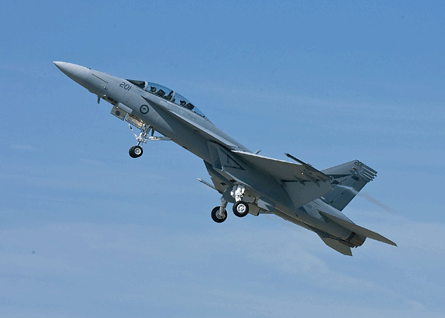Australia envisages that its Boeing F/A-18F Super Hornets, which will begin entering service from March, could become a "long bridge" for an air force capability gap, and remain operational well into the 2030s.
Canberra has ordered 24 of the two-seat aircraft to cover a capability shortfall between the retirement of the Royal Australian Air Force's General Dynamics F-111s by year-end and the induction of the Lockheed Martin F-35 Joint Strike Fighter, projected to take place from 2014.
However, they could stay in use much longer, says Gp Capt Steve Roberton, head of the service's air combat transition wing and officer commanding the Super Hornet wing.
"The aircraft is on time, on budget and over-delivering on capability," says Roberton. "The Super Hornet is giving us flexibility and options, and will be combat-relevant up to the next generation. While we have forecast that they will be operational up until the 2020s, the US Navy plans to use them until the 2030s and there is no reason why we can't do the same."
Australia is due to take delivery of around four Super Hornets in the first quarter and 12 in total this year, when it also aims to declare initial operating capability. Its remaining aircraft, which will also be wired for possible conversion to the E/A-18G electronic-attack configuration, will be delivered by 2012.
 |
|---|
© Boeing |
With the RAAF already operating older F/A-18A/B Hornets, Roberton says the service has bought the "most easy platform that it could adapt to". The new model "has the same philosophy as the classic Hornets, but with more capability", he adds.
"The Super Hornet has increased performance and better flight sensor suites than anything in the Australian Defence Force. With Australia's network-centric capability it can perform a maritime strike role if needed, but it can also take on the air combat role. This is a true multirole fighter that it is built to perform almost any mission," says Roberton - one of the first Australians trained to fly the F/A-18F.
The RAAF's support model for the Super Hornet taps on the US Navy's capabilities, and Boeing says it is working with its launch export customer to develop the in-country systems needed to maintain its fleet.
"We have had to work out which roles are better for the RAAF and which are better for Boeing," says Roberton. "But that is a much better system than what we've had before."
With preparations for the type's introduction having run for more than a year, Roberton says the air force has learned several important lessons - some of which could be vital for potential other regional customers such as India and potentially Japan.
"There is a great deal to do to get everything ready - including the infrastructure and the workforce - to induct a new-generation multirole combat aircraft. The type of training and specialisation needed is totally different from, say, the F-111 or the classic Hornets. It requires a lot of work to ensure that we are prepared."
Engaging the community is also important, he points out, saying that officials from air base Amberley have been working with their neighbours to ensure that there is little impact from noise pollution.
"We have used the Super Hornet as a community consultation process," Roberton says. "A noise flightpath system is now in place, and we did that with them. Their support will be evident in a few weeks, when we believe several hundred of them will come out to welcome the aircraft."
Source: Flight International



















